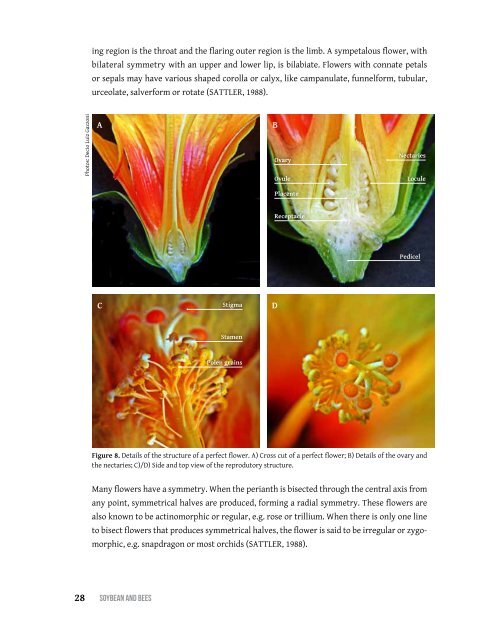Soybean and Bees
Create successful ePaper yourself
Turn your PDF publications into a flip-book with our unique Google optimized e-Paper software.
ing region is the throat <strong>and</strong> the flaring outer region is the limb. A sympetalous flower, with<br />
bilateral symmetry with an upper <strong>and</strong> lower lip, is bilabiate. Flowers with connate petals<br />
or sepals may have various shaped corolla or calyx, like campanulate, funnelform, tubular,<br />
urceolate, salverform or rotate (Sattler, 1988).<br />
Photos: Decio Luiz Gazzoni<br />
A<br />
B<br />
Ovary<br />
Ovule<br />
Nectaries<br />
Locule<br />
Placente<br />
Receptacle<br />
Pedicel<br />
C<br />
Stigma<br />
D<br />
Stamen<br />
Polen grains<br />
Figure 8. Details of the structure of a perfect flower. A) Cross cut of a perfect flower; B) Details of the ovary <strong>and</strong><br />
the nectaries; C)/D) Side <strong>and</strong> top view of the reprodutory structure.<br />
Many flowers have a symmetry. When the perianth is bisected through the central axis from<br />
any point, symmetrical halves are produced, forming a radial symmetry. These flowers are<br />
also known to be actinomorphic or regular, e.g. rose or trillium. When there is only one line<br />
to bisect flowers that produces symmetrical halves, the flower is said to be irregular or zygomorphic,<br />
e.g. snapdragon or most orchids (Sattler, 1988).<br />
28 SoybeAn <strong>and</strong> bees


